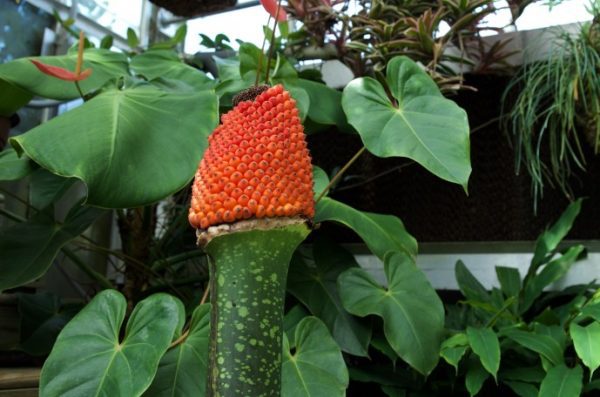Botanical Gardens Pollinates Rare Titan Arum

In a significant botanical accomplishment, UNC Charlotte Botanical Gardens staff have successfully pollinated a Titan Arum, using pollen from another Titan Arum at Daniel Stowe Botanical Gardens.
“The pollination of the Titan Arum is very significant for UNC Charlotte Botanical Gardens,” said Paula Gross, UNC Charlotte Botanical Gardens assistant director. “We were the first to bloom this rare plant in the Carolinas, and now we are the first in North America to have achieved pollination with fresh, or unfrozen, pollen.”
This is the second Titan Arum to bloom at the UNC Charlotte Botanical Gardens, with the first plant – named Bella – blooming in 2007 and 2010. The second plant was named Odoardo or “Odie” in honor of Italian naturalist Odoardo Beccari, who discovered the Titan Arum in Sumatra in 1878.
Titan Arums need pollen from a second plant to reproduce. On their native Indonesian island of Sumatra, carrion beetles move pollen from one plant to another, attracted by the plant’s stench as the bloom opens. In captivity, however, Titan Arums are few and far between. Not only are there no carrion beetles to carry pollen, there usually is no second bloom to receive the pollen.
The blooming of two of these tropical giants within five days and 30 miles of each other offered an unusual opportunity to attempt pollination.
UNC Charlotte’s Titan Arum bloomed on July 17, unfurling its massive bloom throughout the evening and filling the greenhouse with its characteristic odor of dead animal mixed with burnt sugar. As midnight approached and plant enthusiasts watched via a live camera feed, greenhouse manager John Denti attempted pollination.
Earlier in the week, Denti and other UNC Charlotte Botanical Gardens staff had collected pollen from the bloom at Daniel Stowe Botanical Gardens in Belmont, with the permission of staff there.
On August 5, greenhouse staff determined that Denti’s pollination was successful, based on the persistence and growth of the flowering stalk and the swelling and coloring of ovaries. Now, greenhouse staff are waiting, as it can take up to six months for the berries – each containing two to three seeds – to ripen. If ripe seeds are produced, Odie will die off. However, once those seeds are available, the staff will plant and germinate them, with hopes of blooms in eight to 12 years.
“To have a Titan Arum bloom at all is a testament to the expertise of our greenhouse gardeners,”Gross said. “To have gone further by achieving successful pollination represents an opportunity for the UNC Charlotte Botanical Gardens to contribute globally to the propagation of this rare plant.”
Words: Brittany Algiere | Images: Lynn Roberson